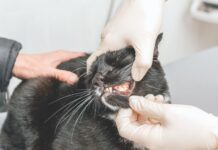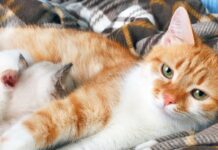Q: My 10-year-old male cat has licked all the hair off his legs and his belly, which appear to be a bit reddish/pinkish in color, as you can see in the photo I have sent. He seems to be an otherwise happy and healthy cat, and we cannot figure out why he does this or what can be done to stop him. He is on a prescription urinary diet that was started years ago when we first got him, and I wonder whether that has anything to do with it. Do you have any ideas about what might be going on?
A: Thanks for getting in touch, and I am very sorry to hear of your boy’s skin issue. While we can’t diagnose him from afar, perhaps a few thoughts about common causes of self-induced hair loss in cats would be helpful.
The first thing to rule out is the presence of external parasites (like fleas and mites) and fungi (i.e., ringworm). The bites (saliva) of these parasites and the presence of fungi can induce allergic reaction in cats, and this can cause itchiness that can make them scratch/groom excessively, resulting in trauma to the hair and ultimately the loss of fur in extreme cases.
Speaking of allergies, a couple of other allergic conditions are important to consider.
The first, and probably least common, is called a contact allergy, in which the skin of affected cats develops allergies to things it comes into contact with. Common culprits include cleaning solutions/fragrances (i.e., potpourri) that are used on floors/carpets, and in some cases, detergents used to wash clothes/linens that a cat may come into contact with. The lesions seen with contact dermatitis usually occur on the parts of the body that come into contact with the offending allergen.
Another consideration is food allergies. Importantly, cats can become allergic to foods even if they have been eating them with no problem for some time. Proteins in foods are most commonly the allergen that sparks a food allergy, and food allergies are diagnosed via a food trial in which the protein source of the food is changed to one that the affected cat has not eaten before (i.e., a novel protein source) and the cat is monitored for resolution of clinical signs.
Importantly, cats on a novel protein source food trial must be fed ONLY the food with the novel protein (no other treats or human food), and they should ideally be kept indoors to prevent their gaining access to outside food sources (such as animals they may prey upon or pet foods in other locations).
Novel protein source food trials should be carried out for a minimum of eight weeks before concluding that the protein source in the original food is not causing an allergy, and it may take several different food trials to ultimately figure out the offending allergen.
Allergies to inhaled allergens (called atopy, like hay fever in people) can also cause itchiness that can result in overgrooming and fur loss in cats. Cats can become allergic to a wide variety of airborne allergens, such as grass and tree pollens, molds, and dust mites, and the itchiness seen in these cases is often seasonal (i.e., worse when airborne allergens are most prevalent, like when grasses/trees are blooming in the spring or when a home’s heat is turned on in the winter, stirring up dust mites in heating ducts). The definitive diagnosis of feline atopy requires skin testing that is most commonly carried out by board certified veterinary dermatologists.
Less commonly, cats can suffer from a condition called eosinophilic granuloma complex (EGC). This disease is an immune-mediated condition that causes significant inflammation of the skin. The exact cause is currently unknown. EGC is usually diagnosed via skin biopsy (talk with your veterinarian).
If all these potential causes are ruled out, one last thing to consider is a behavioral condition called psychogenic alopecia. This is a stress-related disorder akin to obsessive compulsive disorder in which affected cats cannot stop licking/chewing themselves.
Treatment is usually geared toward minimizing stressors, which can take many forms in the average cat (territoriality, moving to a new home, new people/pets in the home, changing food/water/litter box locations, construction within or outside the home, stray cats/birds outside the home that are viewed through a window).
I hope that this brief discussion is helpful, and please discuss these potential causes of fur loss in your kitty with your veterinarian.




